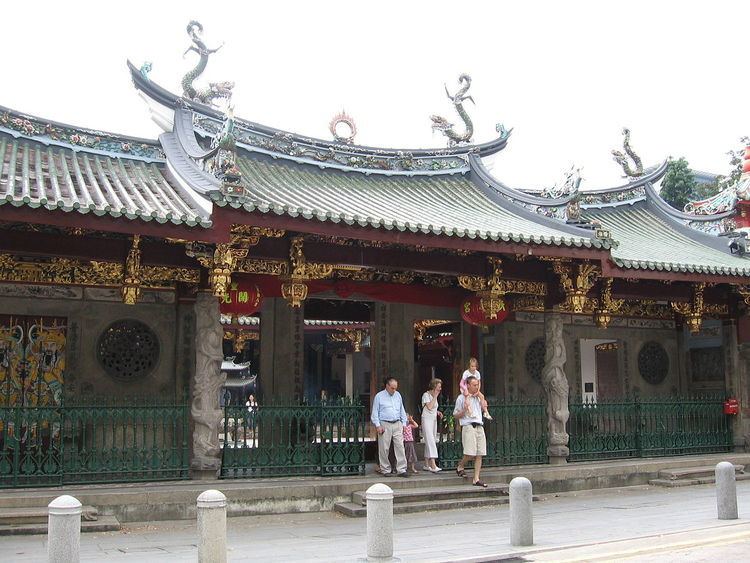Full name Thian Hock Keng Temple Established 1839 | Order Mazuism, Buddhism Phone +65 6423 4616 | |
 | ||
Website www.thianhockkeng.com.sg Similar Sri Mariamman Temple, Buddha Tooth Relic Temple a, Chinatown Heritage Centre, Masjid Al‑Abrar, Kwan Im Thong Hood Ch | ||
Thian hock keng temple singapore
Thian Hock Keng (literally "Palace of Heavenly Happiness"), also known as the Tianfu Temple, is a temple of Mazu ("Ma Cho Po"), a Chinese sea goddess, located in Singapore. It is the oldest and most important temple of the Hokkien (Hoklo) people in the country. Another shrine at the back is Buddhist dedicated to Guanyin, the Mahayana Buddhist bodhisattva of mercy.
Contents
Thian Hock Keng was gazetted as a national monument on 6 July 1973.
Thian hock keng temple
History
The temple originated as a small joss house first built around 1821–1822 at the waterfront serving the local Hokkien community, where seafarers and immigrants may give thanks to the Mazu for a safe sea passage on their arrival to Singapore. The temple is located on Telok Ayer Street that originally ran along the coastline before land reclamation work began in the 1880s. Starting in 1839, the temple was rebuilt with funds collected over the years and donations from the community, the largest of which was from Tan Tock Seng, a Hokkien businessman. The building materials of the temple and a statue of Mazu was brought over from China, with the statue enshrined in the main hall of the temple in 1840. Some of the building materials, such as stone for the columns, timber as well as tiles were recycled from ballasts in ships. The local Indian community of Chulia Street also helped build the temple, and a statue of a man who appears to be an Indian holding a beam up at the ceiling was placed in the right wing as a reminder and gesture for their contribution. The temple was completed in 1842 at a cost of 30,000 Spanish dollars.
In 1840, the clan association Hokkien Huay Kuan serving the Hokkien community was formed within the temple ground of Thian Hock Keng. In 1849, the Chung Wen Pagoda and Chong Boon Gate were added to the right of the main temple. The building was renovated in 1906, and some 'western-style' features were added, such as a wrought-iron gate from Glasgow and dado tiling. A scroll was presented to the temple by Guangxu Emperor to the temple in 1907. The Chong Hock Pavilion was built in 1913, and was once used by the Chong Hock Girls' School established in the temple.
The temple was gazetted as a National Monument in 1973. A major renovation of the temple was initiated in 1998 and completed in 2000 at a cost of US $2.2 million. The renovation received an honourable mention from the UNESCO Asia-Pacific Awards for Cultural Heritage Conservation in 2001.
Architecture
Thian Hock Keng is built on a square site and is of traditional Chinese design whereby a group of buildings or pavilions cluster around the main courtyard. It has the standard layout of three halls commonly found in such temple, with an entrance hall, a main hall, and a rear hall. The temple is constructed in the temple architecture style commonly found in Fujian. The main halls are of single-storey beam-frame structures with brackets supporting curving roofs with wide eaves. Dragons and other decorative motifs are placed on the roofs of the entrance hall as well as the main hall.
The entrance hall has one main door and two side doors, with a high step in front. The side entrances are decorated with coloured tiles with peacocks, roses, and the Buddhist swastika motif that symbolises good luck, eternity and immortality. Guarding the doors are the traditional sentinels of Taoist temple – stone lions and Door Gods. The temple is richly decorated with coloured tiles, red, black and gold lacquered wood, as well as figures of dragons and phoenix, with embellished and gilded beams, brackets, and ceilings.
The entrance leads directly into main courtyard. Overlooking the courtyard is the temple proper where the shrine of Mazu is located. On either side of the temple are pagodas with octagonal base – the one on the left is a shrine of Confucius while the one on the right houses ancestral tablets of the Hokkien immigrants who founded the temple. Behind the main shrine is another courtyard where a smaller altar dedicated to Kuan Yin may be found. Down either side of the temple are aisles leading to the monks quarters.
Worship
The main deity worshiped in the temple is Mazu ("Ma Cho Po"), a medieval Fujianese teenager deified as a Chinese sea goddess. A smaller shrine to Guanyin, the Goddess of Mercy, is located at the back. Other deities worshiped in the temple include Baosheng Dadi (God of Medicine and Health), Guansheng Dijun (关圣帝君, worshiped for spiritual protection), Kai Zhang Seng Wang (开漳圣王, the Sacred Governor Kai Zhang), Qie Lan Pu Sa (伽蓝菩萨, Boddhisattva Sangharama) and Cheng Huang Ye (城隍爷, the City God). Confucius is also venerated in the temple.
